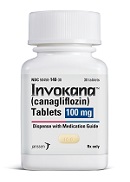 While FDA panelists were weighing safety data on DPP-4 drugs for diabetes Tuesday, Johnson & Johnson ($JNJ) execs were talking up their performance in a rival class of drugs. Their SGLT2 inhibitor Invokana (canagliflozin)--among a handful of drugs in that new category--not only took a big jump in sales for the first quarter but also made some significant market-share gains.
While FDA panelists were weighing safety data on DPP-4 drugs for diabetes Tuesday, Johnson & Johnson ($JNJ) execs were talking up their performance in a rival class of drugs. Their SGLT2 inhibitor Invokana (canagliflozin)--among a handful of drugs in that new category--not only took a big jump in sales for the first quarter but also made some significant market-share gains.
Together with Invokamet, which combines canagliflozin with the standard diabetes-fighter metformin, Invokana brought in $278 million during the first quarter. That's almost triple its results for the same period last year. And compared with the fourth quarter of 2014--when the franchise delivered $201 million--it's a 40% increase.
At a time when the diabetes field is growing more crowded--several new drugs have hit the market just in the last year, and Sanofi ($SNY) has two launching right now--Invokana appears to be solidifying its position in the market.
J&J CFO Dominic Caruso bragged about the sales, but he also highlighted market-share figures. The Invokana and Invokamet duo had 4.9% of the market for non-insulin diabetes meds (not including metformin), up from 4.2% last quarter. With endocrinologists, Invokana's share was even bigger, at 11.8% of total prescriptions and nearly 18% of new-to-brand share.
 |
| J&J CFO Dominic Caruso |
"The product is getting very good acceptance, and it's now … exceeding all the other SGLT2 drugs that have recently come to market, by significant margins," Caruso said during the first-quarter earnings call with analysts. "And it's gaining market share despite increased competition."
That competition would be Eli Lilly ($LLY) and Boehringer Ingelheim's Jardiance (empagliflozin), which launched last August, and a combo pill, Glyxambi, from the same two companies. Approved in February, Glyxambi marries empagliflozin with linagliptin, a.k.a. Tradjenta, a DPP-4 med. AstraZeneca's ($AZN) Farxiga (dapagliflozin) won FDA approval in January 2014, and was Invokana's first competition in the SGLT2 field, but a newer combo version, with metformin, launched just a few months ago, in November.
One of the advantages of hitting a market first is the chance to get ahead with payers, and Invokana has racked up solid coverage, Louise Mehrotra, J&J's vice president of investor relations, said during the call. Invokana and Invokamet sit on tier 2 with 75% of commercial payers, and the drugs have about 85% coverage in Medicare Part D, Mehrotra said. "[S]o we are doing very, very well on the reimbursement front, and we are gaining share in all the categories," she said.
That doesn't mean there isn't room for other SGLT2 meds; unfortunately for the public health, diabetes is widespread, and many patients aren't properly treated. AstraZeneca was able to boast about its own drug's growth in the field in its recent annual report: By year's end, Farxiga was capturing one in three SGLT2 prescriptions, the company said--and the drug helped the entire class grow by 115%. How Farxiga or any of the newer entries stack up to Invokana, dollar-wise, we don't yet know. Neither AstraZeneca nor Lilly have yet reported sales numbers.
- see the J&J transcript at Seeking Alpha
- check out the AZ annual report
Special Reports: Top 10 drug brands by payments to doctors - Invokana, J&J | Top 10 best-selling diabetes drugs of 2013